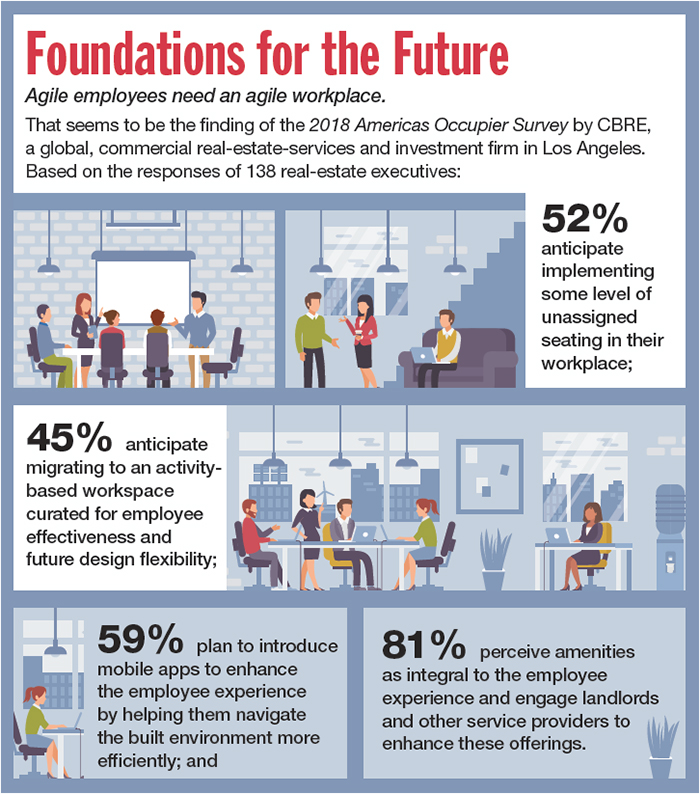In 2015, Be The Match, a global nonprofit that manages a donor registry for marrow and cord-blood transplantation, moved its main office from suburban Minneapolis to a new seven-story building downtown. Of the organization’s 1,000 employees, 95 percent worked at the office and would now have to commute to and from downtown.
“We were moving and had to come up with a way to define our space, make the employee experience different and manageable, not completely overwhelming,” says Nisha Topiwala, the organization’s senior HR manager.
HR wanted its on-site, remote and mobile employees to have more flexibility regarding when, where and how they worked. While exploring design options, she says, HR leaders learned about open workspaces and unassigned desks, which allow employees to work anywhere in the office. The idea appealed to HR and, after conducting research, department leaders presented the concept to the organization’s executives, who agreed and hired Minneapolis-based Perkins+Will architects to design and build an open workspace.
The concept of open spaces and unassigned desks in workplaces has traveled from Europe to the U.S. over the past decade, as employers who moved or were in the process of converting their offices believed it would be difficult to persuade workers to return to a traditional layout with assigned cubicles, offices or desks. Who can blame them? While employers generally save big bucks on their real-estate footprint, employees can pick where they want to work, whether it’s at a treadmill desk, in a lounge or in an outdoor café. These mixed-use spaces not only lead to higher employee engagement and retention, but also better business outcomes–though none of this can happen overnight.
Laying the Foundation
Before moving, HR at Be The Match piloted open-space designs with the IT and patient and health-services teams on different floors and solicited their feedback. Was there enough space? Did their electronic devices work as they moved around the space? Was it too noisy?
“They became our champions and told us what we missed, what was working and what wasn’t so we could keep those things in mind as we continued to do this throughout the whole organization,” Topiwala says. “[Employees in the pilot groups] told us it was very comfortable and loved the ability to write on walls when they had meetings.”
They also appreciated sitting next to co-workers from different departments who were involved in the same project, she adds. That led to employees talking more to each other versus sending emails and built camaraderie.
The building’s first floor now features an auditorium, interview suite and memory walls that display messages or quotes from donors, recipients, family members and volunteers. The remaining six floors support resident and mobile work stations, café-style areas, huddle rooms for meetings, living rooms that resemble open lounges, employee lockers, phone rooms for privacy or meetings and standard conference rooms. Since each space is dedicated to a specific function, employees can also post personal photos on area walls–which are thicker than those in the pilot space to reduce noise, which the pilot groups recommended.
Likewise, HR partnered with IT to add more bandwidth to better accommodate electronic devices and built electronic-storage capability. Multiple communication channels–from emails and webinars to open houses–were also used to address the upcoming office changes.
“We slowly started working with every department,” Topiwala says. “We did a lot of training with leaders on how to manage remote employees and made sure our employees knew what our expectations were.”
Looking back, Topiwala says she has only one regret: HR should have delivered more training for directors and managers so they could be “one step ahead of their change curve than their employees.” Early on, some workers struggled, she says, as they tried to figure out how to do their job without a definitive office.

But within several months, their fears disappeared. Just as important, she says, the new workspace created a different level of trust.
“It’s an amazing feeling you get when your employees realize that you trust them to do the work where they need to work,” she says.
Topiwala partially credits open spaces for decreasing her organization’s time-to-fill from 65 days to 45 days over the past three years.
Europe First
At GlaxoSmithKline, roughly 7,000 of its 15,000 U.S. employees work in open environments in multiple locations, along with thousands more across the world. Its workplace program, called Smart Working and Smart Lab, started with small projects in Europe in 2000 and then moved to its London headquarters, says Ray Milora, head of workplace design at the global pharmaceutical company in Philadelphia.
“The more we built open spaces in Europe, the more we realized it worked not only for that culture but for the people who worked here,” he says, adding that GSK supports 100,000 global employees. “So we crossed the pond and started doing more projects here.”
In 2008, the company created open spaces, sometimes floor by floor, at several facilities in Pennsylvania and North Carolina. In 2011, it hired multiple architects to build a four-story, open-space building at the Philadelphia Navy Yard. The 220,000-square-foot building is encased in glass so everyone can see each other, feel connected and move around, Milora says. The interior also reflects a mixture of traditional desks, treadmill desks, soft-seating areas, catwalks, a rooftop deck and a grand staircase shaped like a spiral or helix, which resembles a DNA strand.
In the past, the company’s environment health-safety team, which reported to HR, introduced standing desks, treadmill desks, centralized printers and trash facilities that encouraged employees to get up and move. Later, Milora’s team, which now manages Smart projects, absorbed EHS’ responsibilities.
According to employee surveys, Milora says, 68 percent reported that their social interactions increased after the move, and 75 percent of employees said they now had access to decision-makers. The number of network printers plunged from 225 in its former building to 30, and printing also dropped off by more than 90 percent. After the move, he says, employee-satisfaction ratings averaged 87 percent.
Milora says his team was “beyond thrilled” with these metrics and now plans to apply this same concept to the company’s lab environments.
With such projects, HR should never discount the importance of face-to-face employee participation, he says. GSK staff attended lunch-and-learns, pilot sessions, tested new furniture and even sampled different brands of coffee. Lab scientists used LEGO models alongside the design team to help design and tweak their own space.

“I’ve been involved in over 2-million square feet of open spaces since I started this role,” says Milora, adding that the work environment can sometimes be more important to employees than their paycheck. “We engage our employee population to really own the space they’re in and make it their own.”
So Far, So Good
Two years ago, Fifth Third Bank created open spaces for roughly 10 percent of its 2,500 workers across several states. They now work at unassigned desks anywhere on campus, in team huddle areas or at stand-up, treadmill or cycle desks. At its Cincinnati office, employees also access ONE67, its 15,500-square-foot innovation center with movable walls, pod spaces and meeting rooms.
“We really made sure that we have the best workspaces for teamwork, to get employees engaged so they can collaborate and work together in an agile type of way,” says Bob Shaffer, CHRO at Fifth Third Bank, which supports 18,000 employees nationwide. “We have an ultimate goal of having our employees do their best individual and teamwork so they can deliver the highest possible results.”
He says the bank’s change-management team led the project but involved IT and HR in the process. It was piloted in its Detroit office, where workers provided constant feedback.
Among the lessons learned, Shaffer says, was the importance of technical support before, during and after any redesign “to ensure that WiFi [is] working and available [and] that there are enough spaces for laptops and other technology devices we utilize in our work.”
Five offices have already been refurbished. So far, no complaints, Shaffer says.
Affected employees were invited to tour open spaces on other floors in their building so they could embrace the concept early on. During renovations, these same workers were assigned to other offices or floors in their building.
Eight more offices are scheduled for renovation this year. By 2020, he says, the bank is expected to save $20 million in annual real-estate and property-management costs.
While saving on real estate is an attractive benefit, open spaces are better known for their ability to attract, retain and engage top talent, says Carol Sladek, partner and work/life consulting leader at Aon, a global consulting firm in Lincolnshire, Ill.
Among HR’s key steps in rolling out this type of project should be reviewing company policies and programs to ensure that they support an open workplace, she says. Conduct employee focus groups to identify their needs, roadblocks and what types of spaces will engage them. Then figure out what specific jobs and people would fit or work best in this type of environment before presenting your plan to company leadership, Sladek adds.
“Once you’ve gotten that [leadership] buy-in, decide to do something and make the change, then it’s really explaining that change to the workforce and making sure that those impacted really do understand that this is a benefit for them and not something being done to them,” Sladek says.
Still, she says, an open-space environment may not work across all company functions–think of a manufacturing plant, she says. In such cases, the company doesn’t have to abandon the approach entirely, but rather can still utilize open designs in administrative areas.
Sladek says such a redesign can be an “extension of total rewards.”
“[Companies should ask] how can we best reward employees who want to work for us, stay and be engaged?” she says. “[Open-space design] is a very powerful tool for driving business results.”
Think It Through
Timing is also critical. Consider organizations that recently underwent a merger or acquisition. It may not be the right time to introduce environmental change that requires workers to be temporarily displaced, adds Ali Payne, global practice leader of wellbeing and engagement at Gallagher, a global insurance-brokerage, risk-management and employee-benefits-consulting firm in Rolling Meadows, Ill.
“Maybe this is something you think about over the course of the next three to five years,” she says, adding departments like IT and communications need to be involved. “You have to be mindful about when and where versus saying you’re going to do this. You want as little disruption for your employee base.”
Companies also need to get buy-in from as many employees as possible. They can act as HR’s advisory team to help create messaging about the overall benefits and goal of the project, Payne says.
Just make sure your culture supports an open workplace, she adds; otherwise, you will be wasting your time. While 10 to 15 percent of her firm’s clients support open spaces, she says, 90 percent of them simultaneously introduced work-from-home programs and believe employees now accomplish tasks quicker and are more productive with the combination of the two approaches.
“Don’t just do it and hope it works,” says Payne. “Think about what the strategy is of your organization and how would you tie that strategy back to your outcomes as an organization before you just start implementing it.”

